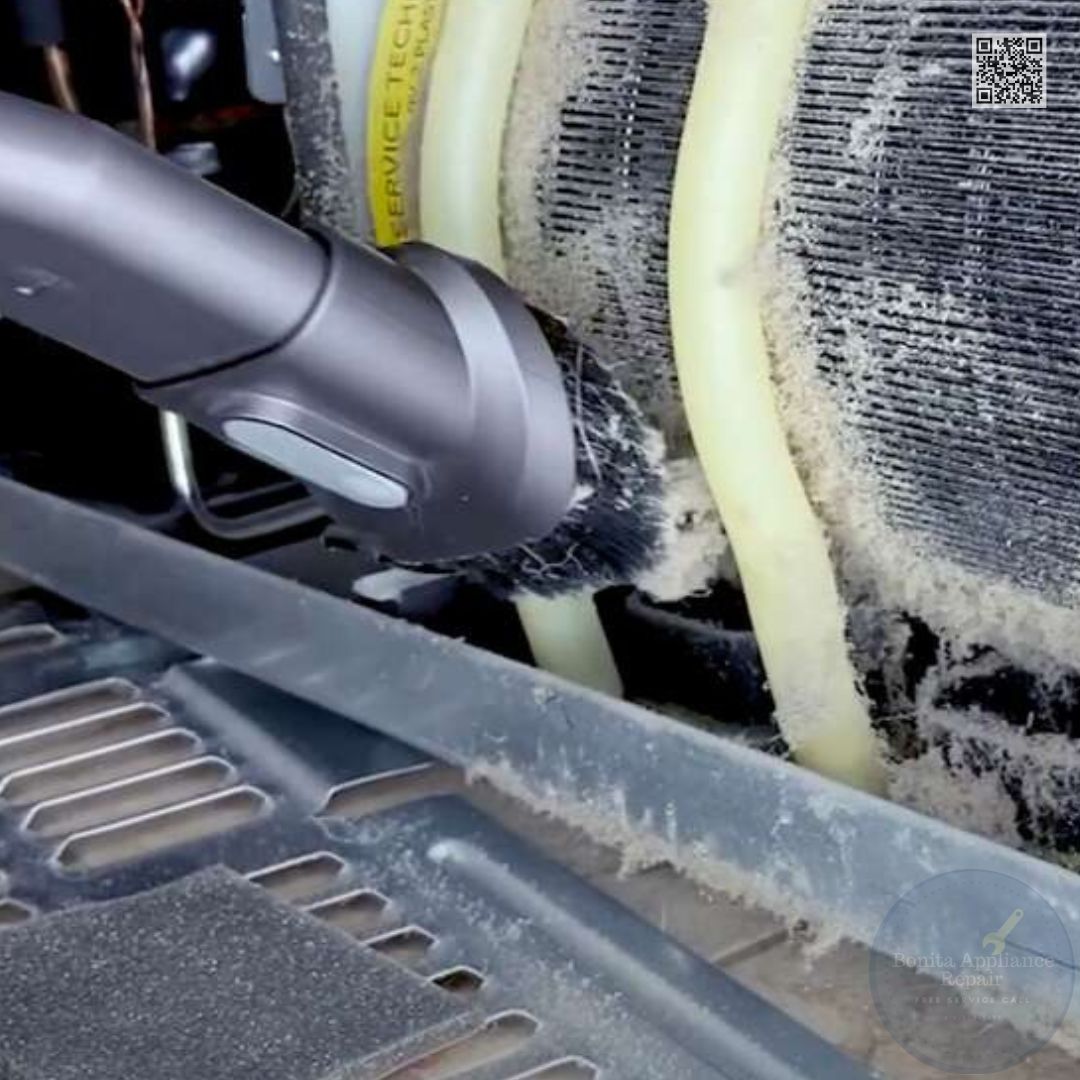How to Clean LG Refrigerator Condenser Coils
Are you ready to give your LG refrigerator a breath of fresh air? Just like a clogged pipe can cause a backup, dirty LG refrigerator condenser coils can lead to inefficient cooling and increased energy bills.
But don’t worry, cleaning your refrigerator coils is easier than you think! In this guide, we’ll show you how to roll up your sleeves and give those coils on your LG fridge the attention they deserve. We’ll take you step by step through the process, from locating the coils to using a vacuum and brush to remove dirt and dust.
So, let’s get started and get your LG fridge running smoothly again by cleaning your refrigerator coils. It’s time to bring back that cool, refreshing feeling!
Key Takeaways
- Regular cleaning of LG refrigerator condenser coils is important to prevent inefficient cooling and higher energy bills.
- Cleaning the coils improves compressor efficiency, extends the lifespan of the refrigerator, and reduces maintenance costs.
- Safety precautions should be taken when cleaning the coils, such as unplugging the refrigerator, wearing protective gloves and goggles, and avoiding the use of abrasive tools.
- Tools and supplies needed for cleaning your refrigerator coils include a vacuum cleaner with a brush attachment, coil cleaning brush, access panel removal tool (if applicable), towel or cloth for wiping, and condenser coil cleaner solution (optional).
Why Clean LG Refrigerator Condenser Coils
To ensure optimal performance and prevent potential issues, it’s essential to regularly clean the condenser coils of your LG refrigerator. Dirty coils can lead to inefficient cooling, higher electricity bills, and even food spoilage or refrigerator breakdown.
Cleaning the coils removes dust, dirt, and debris that accumulate over time, allowing the compressor to pump refrigerant efficiently. This ensures a longer lifespan and lower maintenance costs. By cleaning the condenser coils, you improve the refrigerator’s cooling efficiency, enabling it to work less and consume less energy.
To clean the coils, start by accessing them behind an access panel or by removing the toe grille for front-accessed coils. Use a coil cleaning brush along with a cleaning solution to thoroughly clean between the coils. Vacuuming before and after brushing helps eliminate dirt and dust.
Regular cleaning of the condenser coils at least once a year is recommended for optimal performance, and energy savings, and to prevent breakdowns and food spoilage.
Safety Precautions to Take
Before cleaning the condenser coils of your LG refrigerator, it is important to take necessary safety precautions. This will help ensure your safety and prevent any potential accidents or injuries. Here are some safety precautions to keep in mind:
| Safety Precautions |
|---|
| Unplug the refrigerator before starting the cleaning process to avoid the risk of electric shock. |
| Wear protective gloves and safety goggles to protect yourself from sharp edges or debris while handling and cleaning the coils. |
| Use a flashlight to inspect the coils and surrounding area for any potential hazards or obstructions before cleaning. |
| Avoid using abrasive tools or excessive force when cleaning to prevent damage to the coils or other refrigerator components. |
| Allow the refrigerator to fully dry after cleaning the coils before plugging it back in to avoid electrical hazards. |
Following these safety precautions will help ensure a safe and successful cleaning process for your LG refrigerator condenser coils.
Tools and Supplies You’ll Need
You will need the following tools and supplies to clean the condenser coils of your LG refrigerator.
- A vacuum cleaner with a brush attachment is essential for removing dust and debris from the coils.
- A coil cleaning brush will allow you to reach between the coils and thoroughly clean them.
- If your refrigerator has an access panel, you may also need an access panel removal tool.
- A towel or cloth will be useful for wiping any excess dirt or cleaning solutions.
- Speaking of cleaning solutions, you may choose to use a condenser coil cleaner solution for more effective cleaning.
These tools and supplies will ensure that you can properly clean the condenser coils and maintain the optimal performance of your LG refrigerator.
Step 1: Unplug the Refrigerator
Start by ensuring the safety of the cleaning process by unplugging your LG refrigerator. This step is crucial to prevent the risk of electrical shock while accessing and cleaning the condenser coils. By unplugging the refrigerator, you create a safe environment for maintenance and avoid accidents or damage to the refrigerator components.
To unplug the refrigerator, simply locate the power cord at the back of the appliance and disconnect it from the power outlet. Before proceeding, make sure the compressor has stopped running and the refrigerator has completely powered off. It’s recommended to use a screwdriver or a similar tool to unplug the refrigerator, ensuring a secure disconnection.
Once the refrigerator is unplugged, you can move on to the next step of locating the condenser coils.
Step 2: Locate the Condenser Coils
To begin locating the condenser coils, simply access the rear of your LG refrigerator. The condenser coils are typically located behind an access panel in the back. Look for a panel that can be easily removed or unscrewed. Once you have gained access to the rear of the refrigerator, you’ll be able to see the condenser coils.
They’re usually black in color and look like a series of thin, metal fins. Take a moment to familiarize yourself with their appearance, as this will help you identify them when it comes time to clean them.
Step 3: Remove the Grill or Panel
To access the condenser coils of your LG refrigerator, begin by removing the grill or panel. This step is necessary to expose the coils for cleaning. Here’s how to do it:
- Locate the grill or panel at the bottom of your refrigerator.
- Depending on the model, the grill may be secured with screws or clips. Use a screwdriver or your hands to remove them.
- Once the grill or panel is loose, gently pull it forward or lift it up to remove it completely.
It’s important to note that the method of accessing the condenser coils may vary depending on the specific LG refrigerator model. Refer to your refrigerator’s manual for detailed instructions.
Make sure to have the necessary cleaning tools, such as a vacuum cleaner with a brush attachment, ready before proceeding to the next step.
Step 4: Vacuum Away Loose Debris
After removing the grill or panel to access the condenser coils, you can now proceed to vacuum away any loose debris. Use a vacuum cleaner with a brush attachment to ensure thorough cleaning. The brush attachment helps to dislodge and remove the dirt and dust that may have accumulated on the coils. Make sure to cover the entire surface area of the coils, paying special attention to the spaces in between.
To further clean the coils, you can also use a dust-off disposable compressed air canister. This canister delivers a powerful burst of air that effectively removes any remaining debris. Hold the canister upright and use short bursts of air to blow away the dirt and dust. Be careful not to use excessive force, as this may damage the coils.
Table: Cleaning Tools and Steps
| Step | Cleaning Tool |
|---|---|
| 1. | A vacuum cleaner with a brush attachment |
| 2. | Dust-off disposable compressed air |
Remember to be thorough in your cleaning, as any remaining debris can hinder the performance of the condenser coils. By vacuuming away loose debris, you ensure that your LG refrigerator operates at peak efficiency.
Step 5: Use a Coil Brush for Stubborn Dirt
Now, take your coil brush and thoroughly clean the condenser coils, ensuring that you remove any stubborn dirt and debris. Here’s how to effectively use the coil brush to clean your LG refrigerator:
- Start by positioning the brush between the coils and gently scrubbing back and forth to dislodge any dirt or debris.
- Pay extra attention to areas where dirt may be more compacted or hard to reach.
- Use the brush to sweep away the loosened dirt, making sure to clean both sides of the coils thoroughly.
- Be careful not to apply too much pressure that could damage the delicate coils.
- Continue brushing until all stubborn dirt and debris have been removed.
By using a coil brush, you can effectively clean your LG refrigerator’s condenser coils without causing any damage.
Once you have finished cleaning the coils, it’s time to move on to the next step: cleaning the fan blades.
Step 6: Clean the Fan Blades
To effectively clean the fan blades of your LG refrigerator, begin by carefully removing any accumulated dirt or debris. The fan blades play a crucial role in maintaining efficient cooling and preventing overheating of the compressor. Neglecting to clean the fan blades can lead to reduced airflow and strain on the refrigerator’s cooling system. To ensure optimal performance, follow these steps:
- Turn off the refrigerator and unplug it for safety.
- Locate the fan blades, usually located near the condenser coils.
- Use a soft brush or cloth to gently clean the fan blades, removing any dirt or debris.
- Avoid using excessive force to prevent damage to the blades.
- For hard-to-reach areas, a can of compressed air can be used.
- Once the fan blades are clean, plug in the refrigerator and turn it back on.
Regularly cleaning the fan blades is essential for maintaining the overall efficiency and performance of your LG refrigerator.
| Cleaning Tools | |
|---|---|
| Soft brush | Gentle cleaning |
| Cloth | Removing debris |
| Compressed air | Hard-to-reach areas |
Step 7: Clean the Surrounding Area
You should clean the surrounding area of your LG refrigerator to ensure optimal performance and prevent potential issues caused by restricted airflow.
Here are the steps to clean the surrounding area:
- Clear any debris or dust from the floor and nearby surfaces using a broom or vacuum cleaner.
- Wipe down the surrounding walls and floor to eliminate any dust or dirt that could potentially block airflow to the condenser coils.
- Create a clean and clutter-free environment to facilitate efficient airflow around the refrigerator’s condenser coils.
By cleaning the surrounding area, you’re removing any potential obstructions that could hinder the cooling process. This will improve the overall performance of your LG refrigerator and prevent any issues that may arise due to restricted airflow.
Once you have cleaned the surrounding area, you can proceed to the next step: reassembling the grill or panel.
Step 8: Reassemble the Grill or Panel
After cleaning the surrounding area of your LG refrigerator, it’s time to reassemble the grill or panel.
Carefully line up the grill or panel with the slots or clips, ensuring a secure fit.
Tighten all screws or fasteners to keep the grill or panel in place. Proper alignment is crucial for maintaining optimal airflow.
Confirm that the grill or panel is securely reinstalled by gently pushing on it.
Once the grill or panel is reassembled, you can proceed to the next step.
Plug the refrigerator back in and closely monitor its performance to ensure that everything is functioning correctly.
Step 9: Plug the Refrigerator Back In
After reassembling the grill or panel, securely plug the refrigerator back in to restore its cooling capabilities and ensure proper functionality. Here are some key points to consider when plugging in your LG refrigerator after cleaning the condenser coils:
- Position the refrigerator correctly: Make sure the refrigerator is placed in its designated spot with ample space around it for proper airflow and ventilation.
- Connect to a grounded outlet: Plug the refrigerator directly into a grounded electrical outlet to ensure a stable power supply and protect the appliance from electrical surges.
- Compressor efficiency: Plugging in the refrigerator allows the compressor to efficiently pump refrigerant through the system, maintaining the desired temperature inside the unit.
- Cooling restoration: By plugging in the refrigerator, you restore its cooling capabilities, allowing it to cool and preserve your food properly.
- Prevent breakdowns: Properly plugging in the refrigerator after cleaning the condenser coils helps prevent breakdowns and extends the lifespan of your appliance.
- Lower maintenance costs: Regularly plugging in the refrigerator ensures optimal performance, reducing the need for costly repairs or replacements.
- Energy efficiency: Ensuring the refrigerator is plugged in correctly helps it operate efficiently, minimizing electricity bills.
How Often Should You Clean the Coils
To ensure optimal performance and prevent breakdowns, it’s important to regularly clean the condenser coils of your LG refrigerator. Cleaning the coils at least once a year is recommended for optimal performance, energy savings, and preventing breakdowns and food spoilage.
Regular maintenance frequency is crucial to keep the coils functioning efficiently and to avoid any potential problems. However, depending on factors like the environment and usage, you may need to clean the coils more frequently. For example, if you have pets that shed a lot or if your refrigerator is located in a dusty area, you might need to clean the coils every six months.
By regularly cleaning your condenser coils, you can ensure that your LG refrigerator runs smoothly and efficiently.
Now, let’s move on to the next section and learn about the signs of dirty condenser coils.
Signs of Dirty Condenser Coils
Dirty condenser coils can cause various issues with your LG refrigerator. It’s important to recognize the signs of dirty coils to prevent further problems. Here are some indicators that your condenser coils may need cleaning:
- Increased electricity bills: Dirty coils make your refrigerator work harder to cool, leading to higher energy consumption and increased costs.
- Inefficient cooling: If your refrigerator is struggling to maintain the desired temperature, it could be due to dirty coils hindering proper heat dissipation.
- Food spoilage: When the coils are dirty, your refrigerator may not cool food and beverages effectively, resulting in premature spoilage.
Regular cleaning of the condenser coils is essential to maintain optimal performance and prevent breakdowns. Using cleaning solutions specifically designed for coil cleaning and compressed air can effectively remove dirt and dust buildup, ensuring efficient cooling and energy savings for your LG refrigerator.
Benefits of Regular Cleaning
Regularly cleaning the condenser coils of your LG refrigerator offers several benefits for optimal performance and energy efficiency. By keeping the coils clean, you can ensure that your refrigerator operates at its best, providing efficient cooling and maintaining the freshness of your food. Here are some key benefits of regular cleaning:
| Benefits | Description |
|---|---|
| Improved cooling efficiency | Clean coils allow for better heat transfer, resulting in faster and more efficient cooling. |
| Lower electricity bills | When the coils are clean, the refrigerator doesn’t have to work as hard, leading to energy savings and lower electricity bills. |
| Prevents food spoilage | Dirty coils can lead to inadequate cooling, causing food to spoil more quickly. Regular cleaning helps maintain the freshness of your food. |
| Longer lifespan | Cleaning the coils regularly helps prevent breakdowns and extends the lifespan of your LG refrigerator. |
Common Mistakes to Avoid
To ensure the proper cleaning of LG refrigerator condenser coils, it’s important to be aware of common mistakes to avoid. Here are some key mistakes to steer clear of when cleaning your condenser coils:
- Neglecting to clean the rear coils can lead to inefficient cooling and higher electricity bills. Make sure to access the coils behind the access panel and thoroughly clean them.
- Forgetting to clean other components like the water valve, condenser motor, and fan blade can hinder the performance of your refrigerator. These components should be included in your cleaning routine.
- Overlooking the front coils can also impact the overall performance of your refrigerator. Remove the toe grille and clean the coils carefully using a brush and vacuum.
By avoiding these mistakes, you can ensure that your LG refrigerator’s condenser coils are properly cleaned and maintained.
Now let’s move on to the next section about the importance of cleaning versus professional maintenance.
Cleaning Vs. Professional Maintenance
Maintaining your LG refrigerator’s optimal performance and preventing potential issues can be achieved through regular cleaning or opting for professional maintenance.
Cleaning the condenser coils of your LG refrigerator is a simple and cost-effective way to ensure efficient cooling and lower electricity bills. However, professional maintenance may offer additional benefits such as more thorough cleaning and extended component lifespan.
By choosing professional maintenance, you can have peace of mind knowing that your refrigerator is receiving a comprehensive inspection of the entire cooling system, preventing breakdowns and food spoilage. While cleaning the coils yourself is recommended at least once a year, professional maintenance can provide a more thorough assessment of your refrigerator’s overall condition and offer troubleshooting for potential issues.
Now let’s move on to some extended tips for optimal performance.
Extended Tips for Optimal Performance
For better and more efficient performance, you should regularly keep an eye on the temperature settings of your LG refrigerator. The ideal temperature range for most refrigerators is between 35°F and 38°F (1.7°C and 3.3°C). Setting the temperature too low can cause the compressor to work harder, leading to increased energy consumption and potential damage. On the other hand, setting the temperature too high can result in insufficient cooling, potentially causing food spoilage.
It’s also important to ensure that the refrigerator isn’t overcrowded, as proper air circulation is essential for optimal performance. Additionally, regularly checking and replacing the refrigerator’s water filter is crucial for maintaining clean and fresh-tasting water and ice.
Product Specs:
- LG refrigerator with temperature control settings
- Proper air circulation for optimal performance
- Water filter for clean and fresh water
Pros:
- Better and more efficient performance
- Prevents food spoilage
- Saves money on energy consumption
Cons:
- Requires regular maintenance
- The potential inconvenience of adjusting temperature settings
- Cost of replacing the water filter
Troubleshooting Lg Refrigerators Common Issues
If experiencing issues with your LG refrigerator, start by checking the condenser coils. Dirty or clogged coils can lead to common problems that affect the performance of your fridge. Here are some troubleshooting tips to help you identify and resolve these issues:
- Insufficient cooling:
- Clean the condenser coils to remove dirt and debris that may be obstructing airflow.
- Ensure that the condenser fan is working properly.
- Check the temperature settings to ensure they’re set correctly.
- Excessive energy consumption:
- Clean the condenser coils to improve cooling efficiency.
- Check for any leaks in the refrigerant system.
- Ensure that the door seals are intact and properly sealed.
- Noisy operation:
- Clean the condenser coils to eliminate any debris causing vibrations.
- Check for loose or worn-out components, such as the condenser fan motor or compressor.
Enjoy a Refreshed Fridge!
To keep your LG refrigerator running smoothly and avoid costly repairs, it’s important to regularly clean the condenser coils. Neglecting this maintenance task can lead to inefficient cooling, higher electricity bills, and even food spoilage or refrigerator breakdown.
By cleaning the coils at least once a year, you can ensure optimal performance and lower energy consumption. Start by accessing the coils, which are located either behind an access panel or at the front behind a toe grille.
Vacuum the coils to remove dust and debris, then use a coil cleaning brush to thoroughly clean between them. Don’t forget to clean other components like the water valve, condenser motor, and fan blade.
Finish by vacuuming again to eliminate any remaining particles. By following these steps and using the right cleaning solutions, you can enjoy a refreshed and reliable fridge.
Frequently Asked Questions
Where Is the Condenser on an LG Refrigerator?
The condenser on an LG refrigerator is typically located at the rear of the appliance. It can be accessed by removing the rear access panel.
Regular cleaning of the condenser coils is important for optimal performance and energy savings. Dirty coils can lead to inefficient cooling and higher electricity bills.
Cleaning the condenser coils at least once a year is recommended to prevent breakdowns and food spoilage. Remember to also clean other components like the water valve, condenser motor, and fan blade for thorough maintenance.
How Do You Clean a Condenser Coil on a Refrigerator?
To clean a condenser coil on a refrigerator, first, understand the importance of regular cleaning. Dirty coils can cause inefficient cooling and higher bills.
Access the coils by removing the access panel or toe grille. Vacuum the dust, then use a coil cleaning brush for a thorough cleaning. Vacuum again to remove loosened dirt.
Cleaning the coils once a year is recommended for optimal performance and to prevent breakdowns and food spoilage.
How Do I Clean My LG French Door Refrigerator?
To clean your LG French door refrigerator, it’s important to understand the process of cleaning the condenser coils. Regular cleaning is crucial for optimal performance and preventing breakdowns.
Start by locating the access panel at the rear of the refrigerator. Vacuum the coils to remove dust, then use a coil cleaning brush to thoroughly clean between them.
Don’t forget to clean other components like the water valve and fan blade.
Cleaning the coils at least once a year is recommended for best results.
How Often Should You Clean Refrigerator Condenser Coils?
You should clean your refrigerator condenser coils at least once a year to ensure optimal performance. Regular cleaning helps improve cooling efficiency, saves money on electricity bills, and prevents food spoilage and breakdowns.
Neglecting to clean the coils can result in inefficient cooling, higher electricity bills, and food spoilage. Spending a little time on coil maintenance can significantly enhance your refrigerator’s performance and longevity, making it an essential household task.
Conclusion
In conclusion, regular cleaning of the condenser coils in your LG refrigerator is essential for optimal performance and energy efficiency.
By following the step-by-step instructions provided in this article, you can easily clean the coils and maintain the overall function of your refrigerator.
Remember to also clean other components, such as the water valve, condenser motor, and fan blade, for thorough maintenance.
By taking these measures, you can enjoy a refreshed fridge, avoid breakdowns, and prevent food spoilage. If You need refrigerator repair service in San Diego Call Bonita Appliance Repair. We Provide refrigerator repair services like refrigerator coil repair and much more.

Discovering San Diego's Historic Treasures
Are you ready to embark on a journey through time and explore San Diego’s historic treasures? Join us as we take you on a captivating

Outdoor Adventures in San Diego County
Are you ready to dive into a world of outdoor adventures? Look no further than San Diego County. This breathtaking paradise is like a treasure

Top Restaurants in San Diego
Are you craving a culinary adventure in San Diego? Look no further, because this vibrant city is brimming with top-notch restaurants that will satisfy your

The Complete Guide to Hotpoint Appliance Maintenance in San Diego
Are your appliances leaving you in hot water? Don’t let them burn a hole in your pocket. Introducing The Complete Guide to Hotpoint Appliance Maintenance
Why Choose Professional Hotpoint Appliance Repair Services in San Diego?
Why Choose Professional Hotpoint Appliance Repair Services in San Diego? When it comes to Hotpoint appliance repair services in San Diego, choosing a professional service
Hotpoint Appliances: Common Issues and When to Call a Repair Service in San Diego
Hotpoint Appliances: Common Issues and When to Call a Repair Service in San Diego Are your Hotpoint appliances having Common Issues and ready to Call


